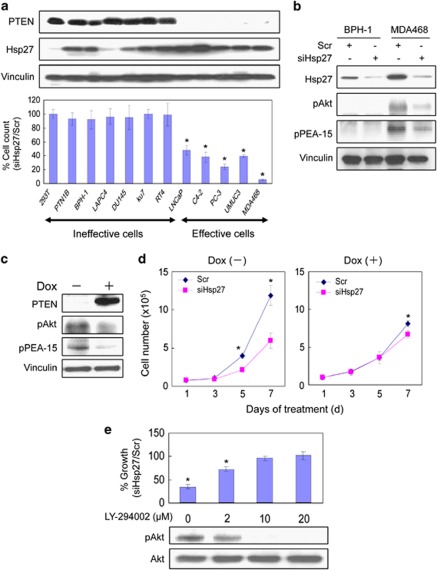Figure 7.
Hsp27 knockdown selectively inhibits growth of PTEN-deficient cells. (a) The effects of Hsp27 knockdown on cell growth were compared among 12 cell lines after transfection with 20 nM Scr or 20 nM siHsp27. The determination of cell proliferation was achieved by direct cell count at 2-day intervals up to day 7 after transfection. The date of transfection was considered as day 1. Data are presented as percentage of control. Cell numbers of control cells treated with Scr were considered as 100%. The levels of expression of PTEN and Hsp27 in each of the cell lines were determined by immunoblotting using the indicated antibodies as described above. Vinculin immunoblotting was performed as a protein loading control. (b) The levels of Hsp27, phospho-Akt and phospho-PEA-15 in BPH-1 and MDA468 transfected with 20 nM Scr or siHsp27 were assessed by immunoblotting. (c) Cell lysates from PTEN Tet-on LNCaP cells treated in the presence or absence of 1 μg/ml Dox for 24 h were analyzed for levels of PTEN, phospho-Akt and phospho-PEA-15 by immunoblotting. (d) Twenty-four hours after preculturing with or without of Dox, cells were transfected with 20 nM Scr or siHsp27, and cell growth was determined at the indicated times by direct viable cell counting. (e) Growth inhibitory effect mediated by Hsp27 knockdown in PC-3 cells after PI3K blockade with LY-294002 was determined by staining cell protein with crystal violet and measuring absorbance at 595 nm. After transfection with 20 nM Scr or siHsp27, PC-3 cells were treated with various doses of LY-294002 (2–20 μM) or control (DMSO). Absorbance of control treated with Scr was considered as 100%. The results (a, d and e) are the means of three independent experiments. Values shown represent mean±S.D. The symbol ‘*' denotes statistical significance (P<0.05)

